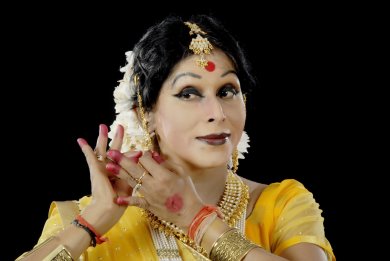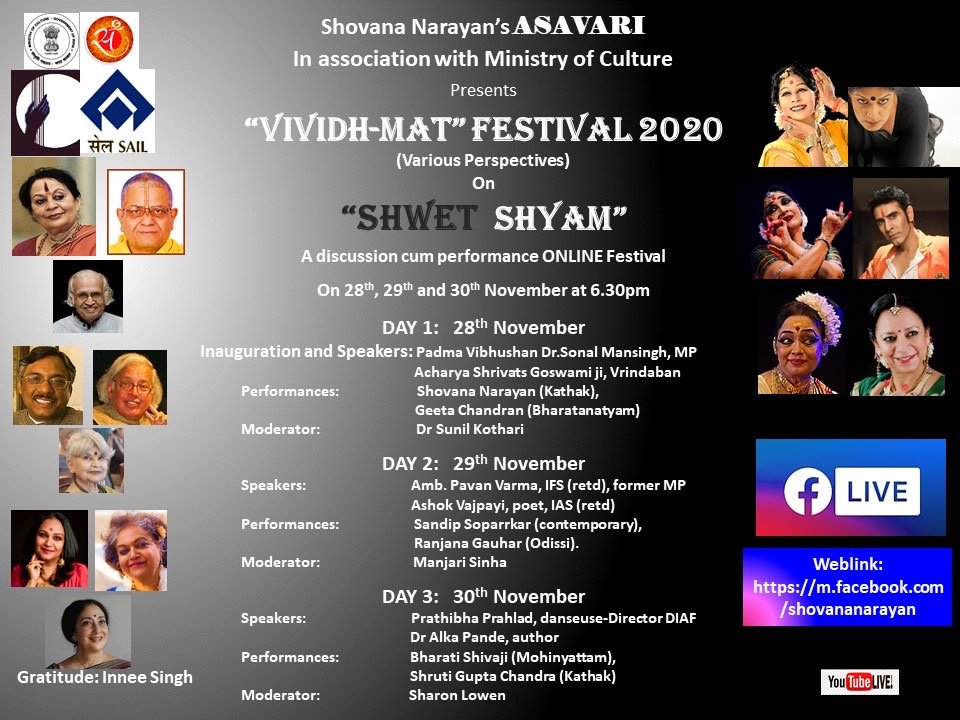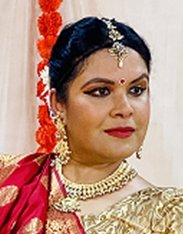
|   |

|   |
"Vividh-Mat" - A confluence of differing perspectives - Anupama Srivastava e-mail: insynckathak@gmail.com December 23, 2020 We live in a very divided world today. From news channel viewership to social media engagement, our carefully curated lives leave very little room for hearing other perspectives as we constantly tune in to content we already believe in. The result is a society bitterly divided with no patience or respect for a differing point of view. At a time like this came 'Vividh Mat', a three day festival by Dr. Shovana Narayan, inviting different perspectives (literal translation of the title) on the topic "Shwet Shyam" (White-Black). Eminent scholars, thinkers, writers, historians, and artists came together to present their views on this subject from November 28-30, 2020.  Dr. Shovana Narayan For the past few years, this annual festival held in New Delhi has brought different perspectives, performances and dialogues on a chosen topic for that year. This year, the online format was a definite positive by-product of the pandemic since a worldwide audience could tune in. This festival was curated by Shovana Narayan's Asavari Institute for Kathak and co-hosted by the Ministry of Art and Culture, Government of India and SAIL (Steel Authority of India). Technical and backend support was provided by Innee Singh. The topic could not have been more apt for 2020, a year filled with unprecedented challenges and ideological conflict. This festival had a stellar lineup of contributing luminaries. Dr. Shovana Narayan played the sutradhaar for this three day festival. From introducing the moderator, guest speakers and performers for the day, to thoughtfully summarizing their perspectives in the end, and then giving just enough preview of the next day, she kept her audience hanging on to each word, eager to tune in the following day. She punctuated the flow with her own perspectives, insights, and quotes from various literary sources. The sheer breadth and depth of thoughts and perspectives expressed in this festival was undoubtedly food for thought for days to come. This article is an attempt to summarize some points that resonated with me. Day one of the festival was inaugurated by a talk from the legendary Odissi dancer and Rajya Sabha Member Dr. Sonal Mansingh. She beautifully analyzed the four terms vividh, mat, shwet, shyam and colored her perceptions with numerous philosophical, historical, and literary contexts. This was followed by another perspective by philosopher, thinker, and Director of Chaitanya Prem Samsthana, Acharya Srivats Goswami of Vrindavan. He highlighted the universal truth that for every situation there is a coexistence of opposing viewpoints, and this duality is the basis of Indian philosophy. The moderator of the evening was Dr. Sunil Kothari, the eminent dance historian, critic, and scholar. Likening this current pandemic phase to a dark (shyam) time, he hailed as a bright spot (shwet) the resilience and creativity of artistes worldwide, and their willingness to embrace the digital format for teaching and performing. These talks were followed by a thought provoking and moving performance by Shovana Narayan titled "Kunti ki Vinati", a Kathak abhinaya piece on a literary work describing the dialogue between Kunti and Draupadi. Such is the power of her storytelling that I found myself nodding in agreement to Kunti's justification and shuddering while imagining the horror of Draupadi's situation. The justification of getting Draupadi married to her five sons, future heirs to the Hastinapur throne, is viewed as right from a mother's context, but not quite so from the bride's, bringing out the two opposing facets of the same story. The final performance of the day was by the eminent Bharatanatyam exponent Geeta Chandran. She mentioned some of her earlier works where she explored different mythological characters and presented them beyond their "black" or villainous characterizations. Her presentation of a traditional repertoire piece from three perspectives highlighted how classical dance items are not set in stone and can be explored in multiple ways. She was brilliant in each of her convincing interpretations - the heartwarming chiding of mother Yashoda, the sensuous invitation of a young nayika, and the soulful pleading of a devotee, all yearning for Krishna.  Day two of the festival started with an introductory talk by Shovana Narayan. She stated numerous examples of how common perceptions of the terms shwet and shyam have evolved contrary to their original perceptions in the past. While supreme consciousness is "Shyam", ignorance is often likened to darkness! While the color white is literally considered devoid of color, scientifically it consists of all the basic colors of the spectrum, each travelling at a different wavelength. These examples, along with many from mythology, namely the many forms of Devi, Shiv-Shakti, Radha-Krishna, and Hari-Hara, all point towards the philosophy of "one truth, many manifestations" blurring the boundaries between black and white. The moderator of the evening was music and dance critic Manjari Sinha. Through beautiful verses and recitations from her evidently vast treasure trove of knowledge in literature, arts, and philosophy, she noted that opposites like good-bad, light-dark, and happiness-sorrow co-exist and accentuate or balance the other. In his enlightening and interesting talk, Ambassador Pawan Varma (retired IFS, former MP, thinker, and philosopher) concluded that contextual circumstances define dharma or right-and-wrong and that there is no absolute right. Through many examples from the Puranas and literature, he brought out that many manifestations of one universal truth may exist. Next, in a talk infused by poetic references, Ashok Vajpeyi (retired IAS, poet, essayist, literary and cultural critic) exquisitely expressed the desired aesthetics of performing arts. Walking the tight-rope between providing a spectacular physical exhilaration and a surreal spiritual experience, great art is a balancing act between "indriya and atindriya" or "rangleen and rangheen" experiences for rasikas. Manjari Sinha masterfully strung the pearls of wisdom put forth in this discussion with her own poetic interjections and insightful comments. Ranjana Gauhar, the celebrated Odissi exponent, chose Hari-Hara as her interpretation of Shwet-Shyam. Comparing and contrasting dark-skinned Vishnu and fair-skinned Shiva, she elaborated on the many mythological symbolisms of these two deities. In continuation of this theme, she presented the gracefully sublime Shiva Stuti Angikam Bhuvanam and a dynamic portrayal of Vishwaroop Darshan bringing to life the eleventh chapter of the Bhagawad Geeta and the vivid imagery of Krishna and Arjun in the Mahabharata battlefield through her spectacular abhinaya. Sandip Soparrkar, the famous Indian Latin and Ballroom Dancer, drew beautiful parallels between the wedding cultures of the east and west and ballroom dancing. He felt that love (denoted by red) was the unifying feeling between the material obsession of wedding planning (denoted by black) and the sincerity of the marriage vows (denoted by white). His graceful demonstration of matching each of the sapta-padi slokas of a Hindu wedding with the seven marriage vows of a Christian wedding and their direct translation into the seven basic stances of ballroom dancing was sheer poetry in motion. This was followed by a contemporary dance duet themed Surpanakha, a character from Ramayana usually painted as dark or evil. Day three of the festival saw the analysis of Shwet-Shyam by art historian, author and museum curator, Alka Pande and Bharatanatyam exponent Prathibha Prahlad. The panel discussion was moderated by Odissi dancer Sharon Lowen who lent her own grace and sensitivity to this discussion. Alka Pande used this platform to showcase the traditional Saura artwork from Orissa. She shared images of the beautiful black-and-white artwork and emphasized, literally and figuratively, that just two simple colors were enough for powerful communication. Lowen eloquently noted that the beautiful artwork was profound, yet so simple, which is probably why it was so profound! Prathibha Prahlad brought attention to the fact that in ancient India, black was not always considered negative or sinister, but these perceptions changed over the years. Through various examples from history and mythology, she brought forth an interesting observation that a dark and dusky complexion was considered beautiful and desirable. The fixation for fair skin prevalent in the Indian psyche seems to be a vestige of more recent centuries of foreign invasion and rule. She also reminded her dancer co-panelists of the taboo against black costumes on stage in yesteryears. Sharon Lowen beautifully summarized that the metaphorical dichotomies of day and night, right and wrong, shwet and shyam have always existed in balance with each other and interpreted in various ways. This discussion was followed by a Mohiniyattam performance by celebrated artist Bharati Shivaji. She presented a fascinating piece described by Adi Shankara which showcases two contrary rasas experienced by Devi, both rendered with equal aplomb and perfection. The graceful expression of love in the usual shringar rasa associated with Devi was contrasted with the more uncommon bhaya rasa that she experiences upon seeing her Lord surrounded by serpents. Bharati Shivaji is lasya personified, and brings out the essence of her dance form beautifully. An award winning painter and Kathak dancer, Shruti Gupta Chandra presented Karna-Kunti Samvaad, an excerpt of "Rashmirathi'' by Ramdhari Singh Dinkar. When Kunti, hailed as the epitome of love, purity, and sacrifice, reveals the secret of his birth to Karna, he is torn between love for his long-lost mother, contempt for the woman who abandoned him, and allegiance to his supportive friend Duryodhana. The strength of the emotions brilliantly portrayed by Shruti Chandra as Karna and Shovana Narayan as Kunti was evident from the fact that one could literally feel the jibes of Karna's sarcasm. This Kathak presentation of the exchange between Kunti on the side of Dharma, and her tormented son Karna siding with Adharma, in the epic war of Mahabharata, questions who is really a black or a white character here, and have they rightly been labeled so. This strong and emotionally charged dance item brought the three day festival to a climax. The biggest takeaway from this festival is an almost unanimous viewpoint presented by all the illustrious speakers and performers -- black and white are as alike as they are different. Although situations and characters might be labeled as good or bad, black or white, there are always shades of gray that exist in between, and often these perceived labels are also interchangeable! There are always two sides of the same coin and multiple perspectives that might exist for each situation. Indian philosophy has always welcomed discussion and debate, and recognized, celebrated, and accepted differing opinions. This has been the basis of intellectual growth of individuals and the society as a whole. At the core of one of the most ancient yet intellectually advanced civilizations of the world is this diversity of perspectives or "Vividh-Mat". Listening to such deep philosophical, literary and spiritual commentary and watching goosebumps inducing dance performances by the legendary maestros has been an enriching experience. The beautiful articulation of language and thought worked as a soothing balm and intellectually stimulating experience at the same time. The openness of discussions and the respect and attention accorded to each presenter by their peers was exemplary in a world plagued with dissent and discord. Contrasting this to the cacophony of voices we often hear in the physical and virtual world around us, arguing, bragging and screaming for attention, the Vividh-Mat festival has been a wonderful oasis of respite. Another bright (Shwet) moment in this dark (Shyam) time!  Anupama Srivastava is a Kathak dancer, and Founder-Artistic Director of InSyncKathak Dance School based in the San Francisco Bay Area, California. After an 18-year career as a hardware engineer in the Silicon Valley, she presently splits her time between dance, yoga, hiking, family, and writing. |